How Long Does It Take to Install Car Speakers
How to install car speakers
General tips for installing car speakers

Installing new speakers is the single most cost-effective improvement you can make to your vehicle's audio system. Not only are aftermarket speakers relatively inexpensive, they usually aren't terribly difficult to install.
You can install most of the speakers we sell using tools that you probably already have. You'll save time and effort with the free brackets, wiring harnesses, and detailed, illustrated Crutchfield MasterSheet™ that we include with your speaker purchase (when available for your specific vehicle).
What you'll need to complete the job
Each car presents its own specific type of installation issues, depending on the factory speaker locations, mounting depth and height, and the vehicle's factory wiring. Most installations are pretty straightforward, but some can be more involved, particularly if you're installing component speakers. Your MasterSheet instructions will specify the exact tools you need, and walk you through the process step-by-step.
The tools you'll need might include, but aren't limited to:
- a variety of screwdrivers (Phillips, stubby Phillips, flat-blade, and magnetic or offset screwdrivers)
- Torx drivers and bits
- drill (with screwdriver and bits)
- Allen wrenches
- socket wrench set
- wire cutter/stripper tool
- soldering iron and solder
- crimping tool and connectors
- panel removal tool
- retaining clip remover (or a screwdriver covered with a shop rag)
- a file
- electrical tape
- hobby knife
Watch this video for a step-by-step overview of a basic car speaker installation
After you read this article, check out this video of one of our senior advisors installing car speakers. He walks you through the process from start to finish and shares a few expert tips along the way.
General tips to make your speaker installation easier
Every car is different, so you may run into issues that aren't touched on in this article. Not to worry. Your MasterSheet has all the details about your car, and our experts are only a phone call away if you have questions. Here are a few general tips to keep in mind as you plan your speaker installation.
Types of installations
After you identify your vehicle in our Vehicle Selector and select the mounting location, you'll see all the speakers that fit your car. Some speakers will fit right into the factory speaker openings and use the factory grilles and brackets.
Other sizes fit with the help of a mounting bracket (free with your speaker purchase), or with minor modifications, such as drilling new screw holes, cutting a small area of metal or pressboard, or filing cardboard or plastic to make room for a speaker that is larger than the factory opening. Thanks to our vast database of vehicle information, we can tell you about any potential challenges that might be involved.
Component speaker systems include separate woofers, tweeters, and crossovers. The component woofers will install in your factory speaker locations, but the tweeters almost always require custom installation, even if your car has factory tweeters. Depending on where you choose to mount the tweeters, this could involve drilling holes in the door panels or dash. In some cars, you can mount them on the sail panels. Learn more about component speakers.
Replacing dash speakers
Most dash speakers are easily replaced by removing the grilles, which are held down by screws or friction fittings. You might need to use a 90-degree (offset) screwdriver to get at the screws near the windshield.
If the grille is held in place by friction fittings, carefully pry it up. To avoid scratching or cracking the surrounding dash as you do this, it's a good idea to use a panel tool to pry up the grille.
If the application of slight pressure is not enough to remove the grille, proceed cautiously. On some cars, the grille is secured from below by screws, or by plastic studs that will break if too much force is applied. If that's the case, the entire dash panel may need to be removed.
Remove the old speakers, making sure to note the polarity of each terminal. (The speaker's positive terminal is the larger of the two, and usually is marked with a "+" or a colored dot.) Use your wiring harness to attach the new speaker, or solder or crimp the connections as your installation requires. You can also use a set of Posi-Products connectors, which are easier and more secure than those methods.
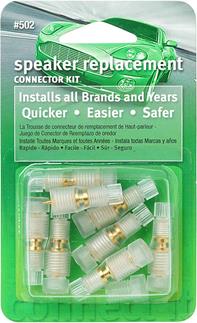
Posi-Products speaker connector kit
If you're going to use electrical tape, say to wrap the soldered or crimped connection, be sure to use a high-quality tape. The danger with electrical tape is that temperature extremes in the automotive environment fluctuate so much that tape can deteriorate and loosen over time. Even if you're using a high-quality tape, it's still a good idea to also use cable ties on each end of the tape to prevent it from unraveling after a few seasons of summer heat and winter cold.
Replacing door speakers
Your car's door speakers are a hugely important part of good sound. They're usually easy to replace, but the degree of difficulty involved in getting to them can vary.
While it's increasingly rare to encounter a car that will allow you to replace the speakers by simply removing the grille and swapping them out, we still see this situation from time to time. Some grilles are mounted by screws or friction fittings, and require you to remove the screws or pry the grille to remove the speaker. There are three basic steps to replacing a door speaker in a vehicle like this.
Step 1. Remove the grille and factory speaker. Be gentle with the speaker, since it's probably attached to a wiring harness and you might want to reinstall the factory speakers if you sell the car later. Some manufacturers also use a sealant or foam when they first mount the speaker, so you might need to cut through that material with a utility knife.
Step 2. Unplug the factory wiring harness, and attach the Crutchfield wiring harness to your new speaker's terminals, again making sure that the polarity is correct. With the wiring harness connected to your new speaker, simply plug the other end of the harness into the factory wiring harness. If a wiring harness is unavailable, use a set of Posi-Products to make the connections. Test the speaker before you put it into place.
Step 3. Check the connections one last time, test to make sure the speaker is working, then re-attach the factory grille.
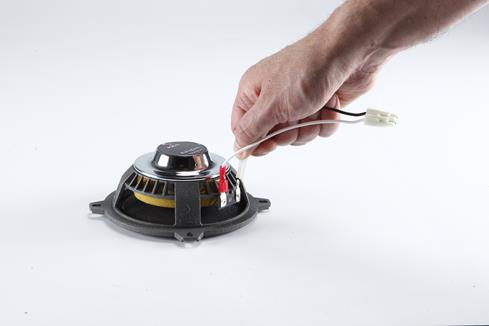
For many speakers, Crutchfield supplies plug-in harnesses to simplify wiring.
If you have to remove the door panel
If the process above seems relatively simple, that's because it really is. Alas, most of us have to do a bit more work to replace our speakers. It's usually not difficult work, but it's more work. Generally speaking, if you have a newer car, you'll need to remove the door panels to replace the factory speakers. As always, your Crutchfield MasterSheet will walk you through this procedure step by step.
If your car has old-fashioned manual windows with a crank, removing that crank is the first step in removing the door panel. Some are secured with a screw at the pivot, which is sometimes hidden by a piece of snap-on trim (like in the photos below).
Most, however, are held in place by a spring clip. We carry an inexpensive retaining clip tool designed to remove this clip, but with a little more effort, you can do it using a shop rag. Depress the surrounding door panel, look behind the crank, and rotate the handle until you see the spring clip. Then use a back-and-forth "shoe shine" motion to ease the clip off of the crank.
Most of the time, though, you'll simply need to pry out and disconnect the electronic control module that controls the power windows and (probably) the locks. These modules are typically built into the armrest, which is often a part of the door panel, so you can basically skip ahead and get to work on removing the panels.
After removing the window crank or disconnecting the power functions, the only thing holding the door panel on should be a a few retaining clips and possibly a few more screws that will need to be removed.
When it's time to remove the panel, start at a bottom corner and pull the panel straight out. Use our trim panel tool and work carefully. This isn't a difficult task, but if you rush through it, you run the risk of damaging the door panel.
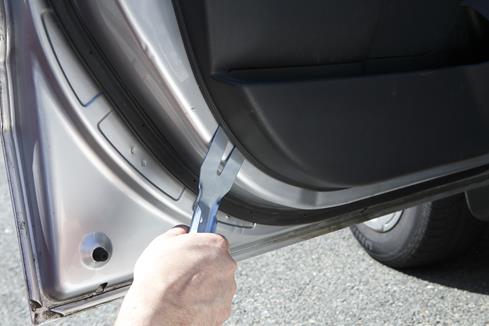
A panel tool can help you remove panels and window cranks without damaging your vehicle's interior.
Once the corner is loose, work across the bottom of the panel and up both sides, again being careful not to use too much force. With the bottom and sides loose, the panel should now be hanging by some trim that sticks down into the window well. Lift straight up and it should come free. Replace the speakers as described in the previous section.
Modifying your door to custom mount full-range speakers
Modifying a car door to accept speakers requires ingenuity and labor, but it also lets you put the speaker where you want it to be. You also can usually choose whether to top-mount or bottom-mount your speaker. Top mounting tends to be easier and requires less mounting depth, but you should choose the option that works best on your vehicle.
This work involves cutting metal, plastic, and/or fabric, so it's definitely a job for an experienced do-it-yourselfer or a talented rookie. (Note: Component speaker installations typically make use of the factory speaker location to mount the woofer. The custom installation of the tweeter and crossover is covered below).
To find the best location for your speakers, look at the template that comes with them. You'll find it with the instructions, or printed on the box. Place the template over the potential mounting areas and observe any obstructions behind the surface (such as interior door parts) or obstacles (such as an irregular mounting surface).
When you examine the surface you're about to cut, make sure that the installation won't affect other mechanisms. In particular, check to ensure that the speaker and grille will not interfere with the windows or locks. Look at the clearance with the window rolled down. If it's close, roll the window up and down before you do anything permanent. Also, close the door. The mechanism that holds the door open can intrude into the speaker cavity.
Check behind the door panel to see how much metal you need to cut from the door frame. Locate the speaker mounting position on the back of the door panel. Tape the template on the exact spot and trace the inside edge with a pen. Lay the panel flat on a clean surface and cut out the circle with a sharp utility knife. Be patient. A dull blade or too much haste might rip the fabric.
Cut your metal using a jigsaw, but be careful here. You need to wear eye protection, and cut very carefully to make sure you don't damage the surface. Don't cut through the door panel and metal at the same time. If you try to cut both layers at once, you might rip the panel covering. When cutting exposed metal or metal covered by a plastic panel, wrap the base of the saw with electrical tape to prevent marring. Also, keep the blade clear from the car's exterior, where it could cause pockmarks. Vacuum the debris when you are finished.
Connecting the full-range speaker in your modified door
You might need to do a little extra work to connect the speaker you've installed in a non-factory location in your door. Start the wiring process by using the factory rubber tubing between the door and the door jamb to run speaker wires from the door into the car body. (If needed, you can get some from the car dealer or a junkyard.)
If you don't see a factory boot or plug, use a drill to create a 5/8" hole. Make sure the hole gets you to the desired speaker location. Sometimes, structural steel supporting the hinges will isolate this edge of the door.
Protect the wiring from the sharp edges of the holes with a rubber grommet or flexible tubing run between the two holes. This will keep the insulation from getting damaged when you open the door. Also, position the wire where it won't be pinched by the hinge or a portion of the door jamb. Leave enough slack so the door can open all the way.
If your new speaker is designed to be top-mounted, you can replace the door panel after you run the wire through the jamb. (If you're using bottom-mount speakers, attach the speaker to the panel before you reassemble the door.)
When the door panel is properly positioned, push the friction fittings back into their seats and replace enough of the screws, armrest, etc., to hold the panel loosely in place. Do not clip on the window crank, since you might have to remove the panel again.
Hold the speaker in its new home, mark the screw holes and remove the speaker. Drill the holes. Crimp quick-slide terminals onto your speaker wire and connect the wire to the speaker, noting the proper polarity. If you can, use "speed clips" over the new screw holes. Speed clips are slotted pieces of metal through which you drive the screw. They give the screws something extra to hold on to, providing support when the door is slammed.
After you've attached both speakers to the panels, connect your wires to your receiver or amplifier and listen to some music. If they work properly, finish re-attaching the panels, window cranks, door handles, and trim pieces.
Installing rear speakers
The ease or angst of replacing a set of rear speakers varies wildy, depending on the type of car you have and the way the manufacturer designed the interior. In some cases, all you need to do is pry up the grilles and swap out the speakers. In others, you need to crawl into the trunk and disconnect them there. And in some cases, you'll need to remove the back seat and most of the rear trim pieces. It all depends on your car. Thankfully, our Crutchfield MasterSheets can walk you through the process with step-by-step instructions.
Let's take a look at a speaker installation to get an idea of what's involved. We'll be going step-by-step through a component speaker installation in the doors of a Ford Ranger pickup.
Installing a component speaker system in a 1996 Ford Ranger pickup
1. Disconnect the battery — Your car doors are going to be open while you install the new speakers. Disconnecting the negative terminal of the battery prevents you from draining your battery and getting stuck without power. It also safeguards you against a dangerous short circuit in your vehicle's electrical system.
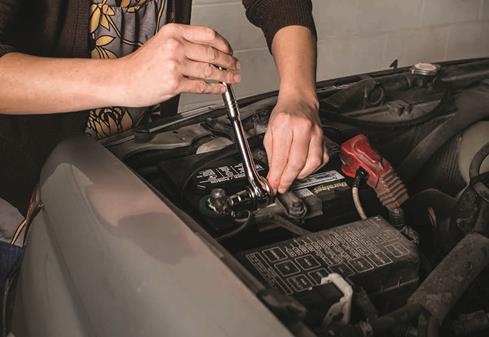
2. Prep your parts — Remove the new speakers and hardware from the box. If you're installing full-range speakers, you'll typically have the two speakers, speaker wire, mounting screws, speed clips, and instructions. Some aftermarket speakers include grilles as well. If your speakers do not come with grilles, use your factory grilles. If you're putting in component speakers, you'll also have the separate tweeters, the tweeter mounting hardware, and crossovers.

We'll include your free Crutchfield wiring harnesses, speaker brackets (if necessary), and MasterSheet instructions with your order. We recommend purchasing speaker baffles with your new speakers as well — they improve sound, especially bass, and help dampen unwanted resonances and vibrations.
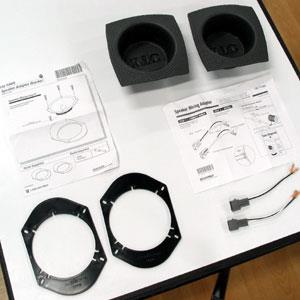
If you are installing component speakers, start thinking about where to install your tweeters, and what type of mounting you want to use (angled, flush, or surface). You'll want to locate the tweeters above the woofer and "aim" them up at your ears to achieve a realistic soundstage and stereo image. But you don't want to install the tweeter too far from the woofer — ideally, the tweeter should be no more than a foot from the woofer to maintain a unified sound field. Of course, the dimensions of your door and aesthetic considerations will also factor into your decision.
3. Door disassembly — Depending on the factory speaker locations, or where you've decided to custom-mount your speakers, you can now begin to remove your old speakers. Your MasterSheet instructions will show you how to remove the factory speakers. In this example, the Ranger's speakers are located in the doors.
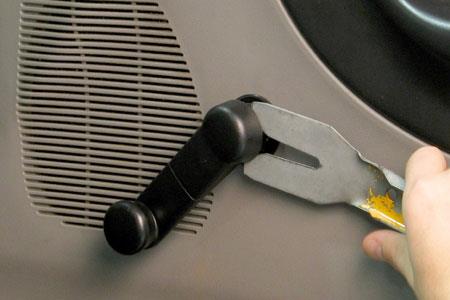
The first step is to remove the window crank. Like we said above, some vehicles would require a window crank removal tool to release a spring clip, but in this truck, the crank is held on by a screw. We used our panel tool to pry off the window crank cover. Then, we removed a Torx T-20 screw and removed the crank.
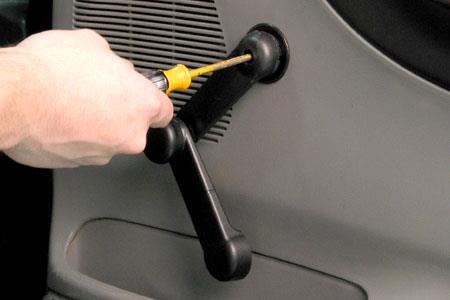
Next, following the MasterSheet instructions, we removed a few Phillips screws and the door cup.
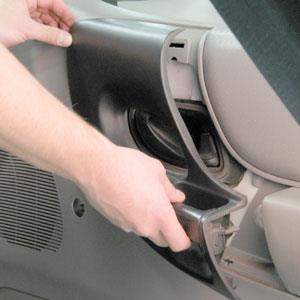
There was one more Phillips screw beneath the door pull cup, so we removed it, then slid the door panel up and off the door.
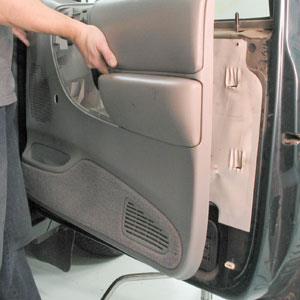
4. Removing the Factory Speaker — The factory speaker is secured to the car door with four Phillips screws. We removed them, then pulled the speaker out of the opening. Using a flat head screwdriver, we popped off the factory harness and removed the factory speaker.
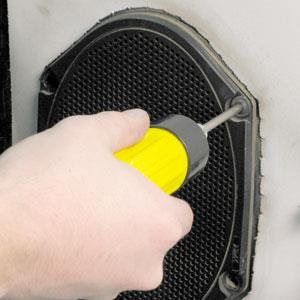
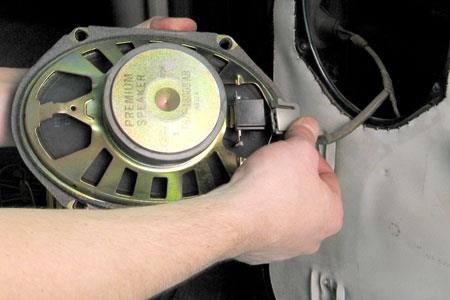
5. Prepping the crossovers — Component speaker systems use an external crossover to divide the frequency bandwidths between the tweeter and woofer, so we needed to solder the free Crutchfield wiring harness to the crossover's input wires. We cut off the wiring harness' quick slide connectors and stripped the wires. We also stripped the crossover's input wires and placed some heat shrink tubing on them before twisting them together with the wiring harness wires.
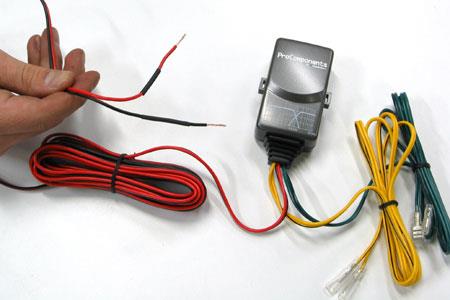

After soldering the wires together, we used the heat gun to melt the heat shrink tubing and protect the connection. Then we connected the crossover to the factory wiring with the quick connect wiring harness.

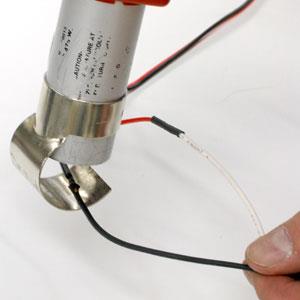
Note: If you're not comfortable with soldering, use a set of Posi-Products connectors. It's an easier way to do the job, plus these connectors will give you a solid, long-lasting connection.
6. Installing the woofer — The 1996 Ford Ranger uses 6"x8" speakers in the front doors; but the component system we purchased has 5-1/4" woofers. Using the free Crutchfield speaker bracket, we can adapt the 6"x8" factory speaker opening to accept a 5-1/4" woofer. We used the factory speaker screws to secure the mounting bracket to the factory opening.
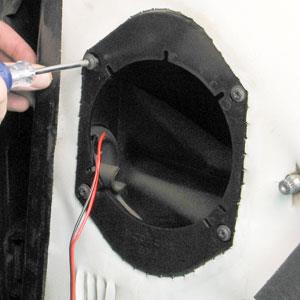
Then we placed the baffle in the bracket and screwed in the woofer. (If we had been installing full-range speakers, we'd now reverse these steps, re-attach the door panel, and be done.)
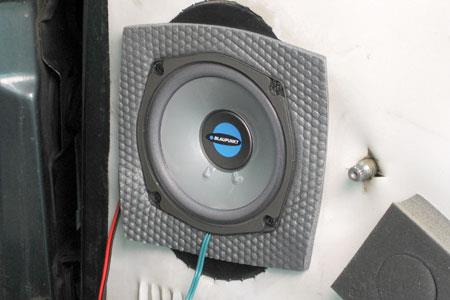
7. Installing the tweeters — We chose to angle-flush mount the tweeters. Acoustically and aesthetically, this is usually the best way to mount component tweeters. However, angle-flush mounting requires you to drill a hole in your door panel large enough to accommodate the entire tweeter cup.
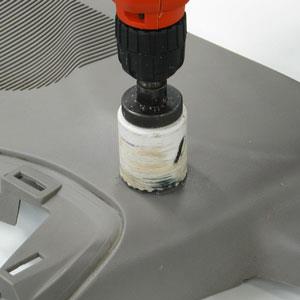
We decided where to mount the tweeters, then used a pencil to trace around the outline of the tweeter cup. With the aid of a hole saw kit, we drilled out a hole for the tweeter, then trimmed the cutout with an hobby knife.
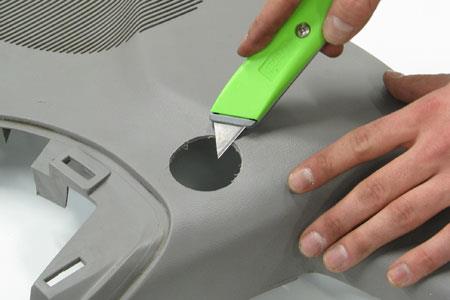
Each manufacturer has a different system for securing the tweeter to the mounting surface — this one used a spring clip that attaches to the back of the tweeter with a screw to achieve a tight, secure fit. We angled the tweeter up and in towards the driver's seat for optimal imaging.
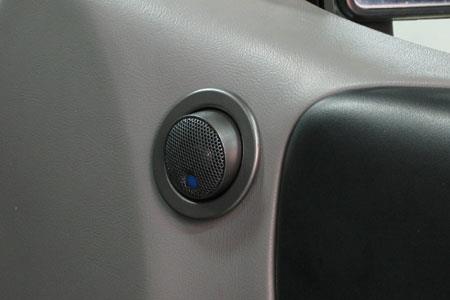
8. Completing the installation — We connected the woofer and tweeter leads to the crossover with the attached quick slides. We used the included wire ties to gather the excess cable and routed the speaker wires around the window crank. Then we dropped the door panel back onto the door.
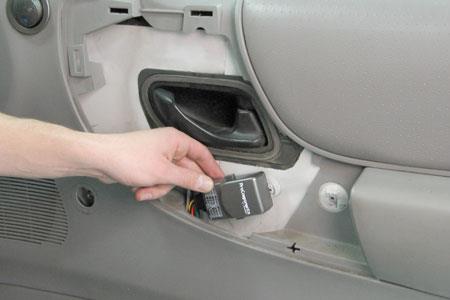
The crossover fit snugly between the door panel and the door frame, so we secured it there. Then we replaced the screws, the door pull cup, and the window crank. Now we have full-bodied, detailed sound, a deep and spacious soundstage, and vibrant stereo imaging — what a difference!
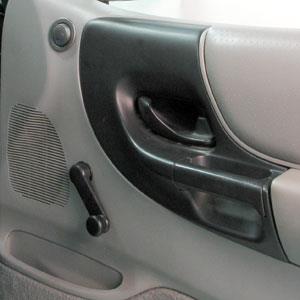
How Long Does It Take to Install Car Speakers
Source: https://www.crutchfield.com/ISEO-rgbtcspd/learn/car-speakers-installation.html